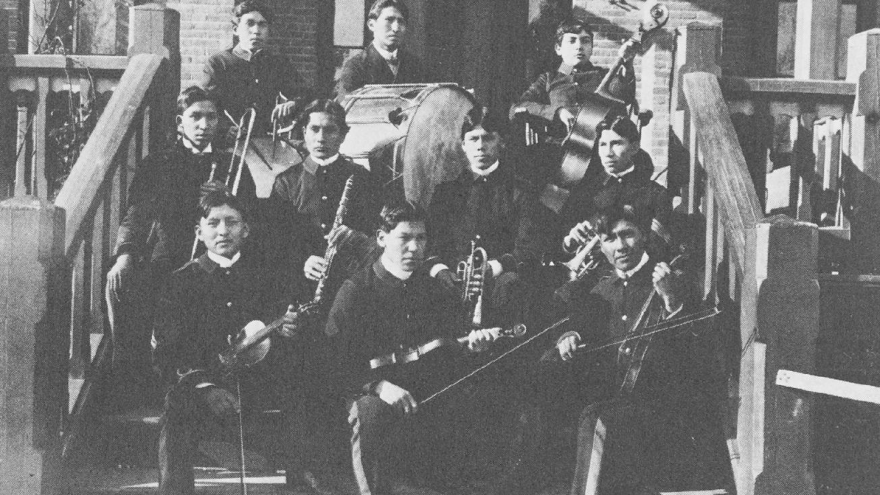Read the original story on WHRO's website.
Robert Scholar, also documented in some places as Robert Marsh, was a Pamunkey boy with exceptional penmanship who acted as a notary between his tribe and colonial settlers.
One of his classmates, a student from the Cherokee tribe named Charles Murphy, became a translator for Patrick Henry during the American Revolution.
That’s all according to new research about the Indigenous children who attended William & Mary’s Brafferton School, a colonial-era Indian residential school.
What the researchers found is notably different from the violent and traumatic stories that have emerged in recent years about 19th- and 20th-century residential schools across the U.S. and Canada — which included one in Virginia at Hampton University.
The Brafferton School was a mark of honor for Indigenous tribes around the country, said Danielle Moretti-Langholtz, director of William & Mary’s American Indian Resource Center. She researched Brafferton alumni and curriculum, and has worked with tribes around the country to uncover the school's history.
This year is the 300th anniversary of the Brafferton Building’s construction on the William & Mary campus. The college now uses it for administrative offices and doesn’t plan to move or convert it to an educational center, like it's done with the Bray School.
“Both the Brafferton Initiative and the Bray School Lab are engaging descendants and descendant communities to develop joint programming and determine together how best to carry out research and disseminate the findings on these historic sites and their legacies,” college spokesperson Suzanne Clavet wrote in an email.
Moretti-Langholtz’s team believe tribes as far as Canada and modern-day Oklahoma sent children to Brafferton. Researchers were also able to confirm students from Virginia’s Pamunkey and Nottoway tribes attended the school.
At Brafferton, children learned English and other subjects that would allow colonists and tribes to better interact. But it wasn’t always an even exchange. While Indigenous children learned English and writing, British colonists did not make the same efforts to learn tribal languages or cultural practices.
Native children learned enough to become translators for business exchanges, stenographers to keep records and even performed duties similar to those of modern-day notaries.
“That's a different story where native tribes see some benefit to having their own people, their young people, serve as interpreters, explain the culture, and also understand the culture and the rules of the other group,” Moretti-Langholtz said.
The Brafferton School was funded by the estate of the wealthy British scientist Robert Boyle. Proceeds from a property in Boyle’s estate, the Brafferton Manor, funded the program starting in 1695 and gave the school its name.
In 1723, there was enough money coming from the estate to construct the Brafferton Building, which still stands today.
The school closed in 1790 after the American Revolution, in which several Brafferton students participated, Moretti-Langholtz said.
“Robert Marsh is a student at the Brafferton and he's from the Pamunkey. He actually fights with the Americans,” Moretti-Langhotlz said. “He is captured, [becomes a] prisoner of war in Charleston, is part of a prisoner swap, comes back and fights again with the Americans. He's at Yorktown during the surrender. That's an extraordinary story.”

The Brafferton School focused on education to make more useful allies out of Indigenous tribes, but was followed by a government-funded concept of Indian residential schools starting in 1819. The schools opened specifically to erase Indigenous culture, language and practices to eliminate perceived threats against white settlers in the United States.
By forcing Indigenous children into those schools, tribal cultures would disappear and eventually, valuable tribal land that settlers wanted would become less populated and easier to take. The schools forced or coerced Indigenous parents to send their children to the schools, where there was widespread systemic abuse that sometimes turned fatal. In cases where students didn’t die at the schools, there wasn’t always a plan to get them back home.
The largest residential schools in the U.S. were out west, but Hampton University taught 1,388 Indigenous students from 65 tribes at their own Indian residential program between 1878 to 1923. Hampton’s school was unique because it used a mix of federal money and local donations for their Indigenous students.
The first class of students came from Fort Marion in St. Augustine, Florida. A group of Indigenous men from various tribes were held as prisoners of war from the ongoing Indian Wars of the 19th century. Army Capt. Richard Henry Pratt oversaw those prisoners and taught them various topics during a three-year imprisonment. When it was time for their release, he offered to send them back to their tribes or find them somewhere to continue their education.
Seventeen men opted to keep learning and arrived in Hampton during April 1878.
Since Hampton received federal funding for its Indigenous students, it was supposed to teach a specific list of topics in the residential school curriculum.
But as a school for Black students, Hampton’s founder and leader at the time, Gen. Samuel Armstrong Chapman, saw similarities in how Black and Indigenous students were regarded outside of school. He thought eliminating all traces of nonwhite language, music, art and more, taught students to disrespect their own cultures.
Armstrong decided his school would allow Indigenous students to maintain some connection to their tribes, especially through music.
Researchers said Indigenous students were encouraged to sing and speak in their native tribal languages, an uncommon practice for residential schools that used language as a way to break students’ connections to their roots.
Indigenous students at Hampton learned plantation songs and hymns alongside Black students, and over time, several student music groups formed. There were Indigenous-only bands, where students played a mix of their tribal songs and Americanized music.
Eventually, students formed a mixed orchestra that became the school’s first, called the Mandolin Orchestra.
Allowing Indigenous students to continue using their native language was one of the reasons the federal government rescinded its funding of Hampton’s residential school in 1912, effectively ending the program.


